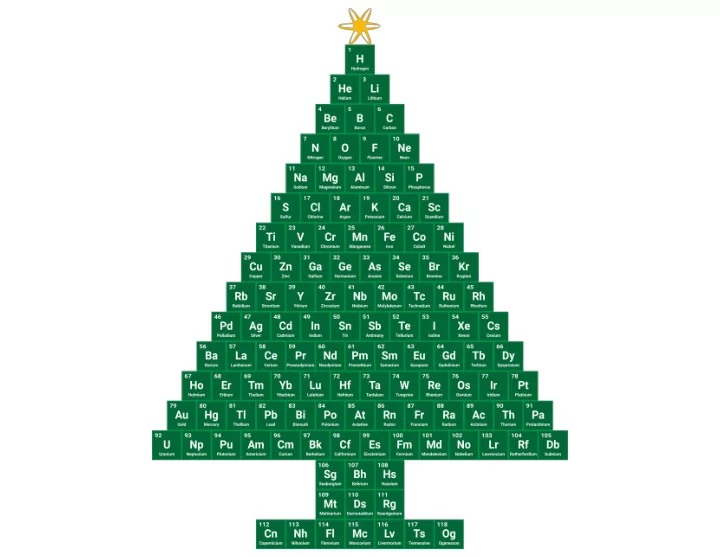

Outline for Today Friday, Dec. 7 • Festivities • A Non-Exhaustive Overview of CH 141 • Selected Integrative (and Challenging) Example Problems � 2
Final Exam Review Opportunities • Review Session: 4pm - 6pm Sunday Dec. 16th, Keyes 105 • Prof. Madison’s O ffi ce Hours: 1pm - 2pm Monday through Friday • Monday and Tuesday, Keyes 104 (Chem Help Center) • Wednesday through Friday, my o ffi ce Keyes 314 • By Appointment: Expect an email today! One appointment per person. First come, first served.
Note Card Warm-Up Exercise • 1) Name • 2) Why do we use salt to melt ice? • 3) Why do we add salt to pasta water? • 4) Why does warm soda go flat?
The Big Questions in General Chemistry • What is our material world is made of? • How and why do atoms stick together to form molecules? • Why do molecules and materials have the properties that we observe? • How do molecules chemically react?
What is our Material World Made of? Chemicals! • You should now be able to: • For any molecule that we’ve talked about in class, you Ch 8 should now be able to: • Draw the best possible lewis structure. Ch 9 • Predict 3D shapes of molecules. Ch 9 Ch 2, 9, • Describe a molecule’s properties based on its structure. 11, 13
What is our Material World Made of? • Relate certain names to chemical and/or empirical Ch 2 formulas. • Describe the structure of atoms or ions based on Ch 2 subatomic particles (protons, neutrons, and electrons). • Describe the electronic structure of atoms, ions, and molecules using quantum numbers, molecular orbitals, Ch 6 electron configurations, etc. Remember, this list is just a starting places. It is not exhaustive!
Example Problem: Drawing Lewis Structures • Draw the lewis structure and predict the 3D shape for phosphorous-dichloro-diflouride. What are the angles? Cl F F Cl Ch 8 and 9
Example Problem: Behavior of Electrons What orbital is this? What are the quantum numbers for this orbital? Which regions of this orbital are most responsible for shielding? Ch 6 and 7
Example Problem: Atoms, ions and their subatomic particles • Sort the following by increasing radius: 1. Ca, K, S, and Cl 2. K + , Ca 2+ , S 2- , and Cl - • Using the subatomic particles, explain why. Ch 7 and 2
Why do Molecules and Materials Have the Properties that They Do? • You should now be able to: • Distinguish physical properties from chemical properties. Ch 1 • Relate molecular shapes and polarity to chemical Ch 11 properties. • Numerically analyze the behaviors of gases, liquids, Ch 10, 11, 12 solids, and solutions.
Why do Molecules and Materials Have the Properties that They Do? • You should now be able to: • Relate electronic structure of diatomic molecules to Ch 9 molecular properties. • Relate electronic structure to periodic trends. Ch 7 Remember, this list is just a starting places. It is not exhaustive!
Example with Molecular Structure of DNA • The DNA base pairs are Thymine and Adenine, Cytosine and Guanine. • Which pair of DNA bases is more stable to heating? AT or CG? • Why? Ch 8 and 13
Example: Photons and Electrons in modern materials (Nanoparticles) smaller larger nanoparticles nanoparticles Lowest Unoccupied Ag HOMO Photon absorption! Highest Occupied Molecular Orbital 1 x 1 0 -9 m Many more electrons below here!
λ = looks red smaller larger absorbs nanoparticles nanoparticles green λ = If a solution absorbs green light, then it appears red to us. Question: Based on the color of the solution, which nanoparticles, (smaller or larger), absorb photons with the most energy? E = hc hint: λ
How do Chemicals React? • You should now be able to: • Balance chemical reactions Ch 3, 4, 20 • Write chemical reactions between di ff erent molecules based on the type of reaction (acid-base, precipitation, combustion, etc.) Ch 3, 4, 20 • Using the concept of limiting reagent, determine what is produced from a reaction. Ch 3, 4, 10
How do Chemicals React? • You should now be able to: • Quantitatively account for energy flow (absorbed or Ch 5, 6, 11 emitted) in a reaction in terms of heat, work, or light. • Relate the enthalpy of a reaction to thermodynamic Ch 5, 11 processes like heating, cooling, and phase changes. • Relate enthalpy changes to changes in chemical bonding because of a reaction. Ch 5, 8 Remember, this list is just a starting places. It is not exhaustive!
Example of Redox Reactions and Enthalpy of Reaction • When 500.0 mL of 0.50 M Cr 2 O 72- is mixed with 9.0 g of Al(s) and excess H + (aq), it forms Al 3+ (aq) and Cr 3+ (aq) through a redox reaction. • After the reaction takes place, what is the concentration of Al 3+ (aq)? • Does the solution boil? Assume the solution starts at 4 o C. Important topics • Important data for this problem: Redox Reactions • • C p (solution) =4.1 J/g o C Limiting Reagents • • K b =1.86 o C / m ∆ H rxn • Density of solution at 4 o C= 1.00 g/mL • Heat capacity • ∆ H rxn = -1500. kJ/mol Cr 2 O 72- • Boiling point elevation
Recommend
More recommend